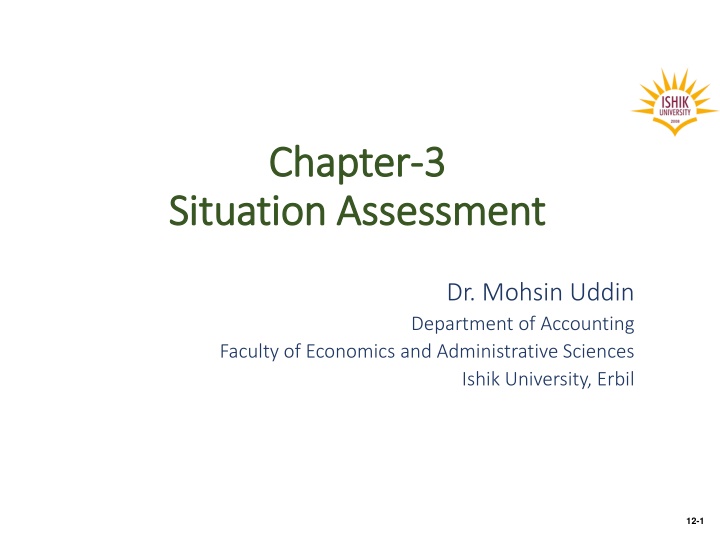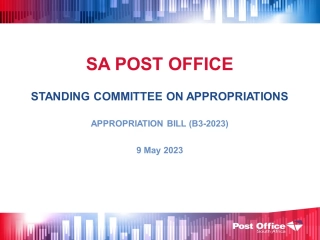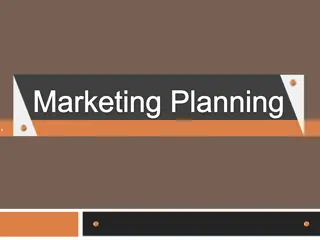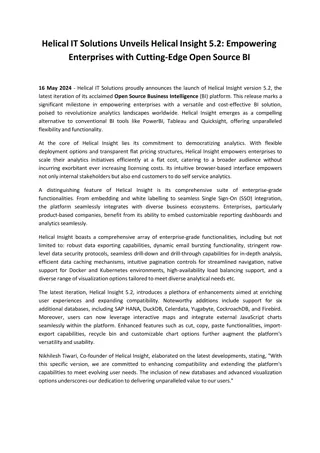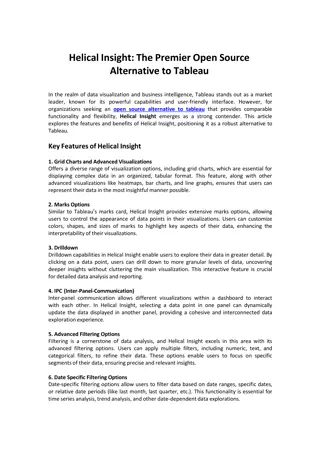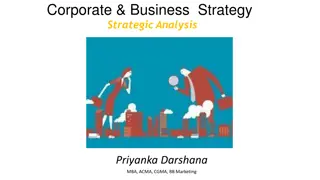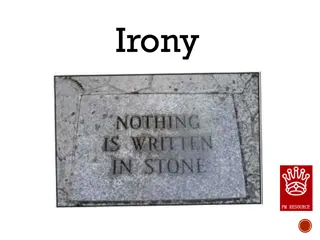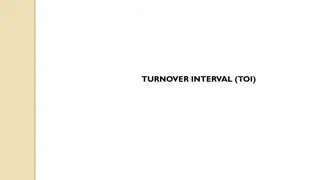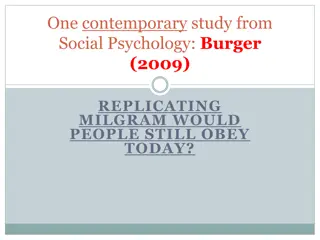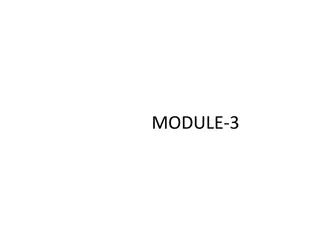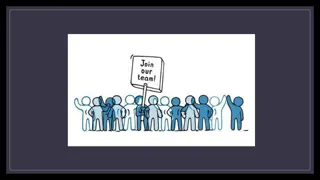Situational Analysis for Strategic Insight
Situational analysis aids in grasping the internal and external factors affecting an organization. Assessing the environment, opportunities, and threats helps in making informed decisions. Competitive analysis uncovers strengths, weaknesses, and potential market niches, guiding pricing strategies and innovation. Understanding industry best practices and market saturation prevents costly mistakes and redirects efforts effectively.
Download Presentation

Please find below an Image/Link to download the presentation.
The content on the website is provided AS IS for your information and personal use only. It may not be sold, licensed, or shared on other websites without obtaining consent from the author.If you encounter any issues during the download, it is possible that the publisher has removed the file from their server.
You are allowed to download the files provided on this website for personal or commercial use, subject to the condition that they are used lawfully. All files are the property of their respective owners.
The content on the website is provided AS IS for your information and personal use only. It may not be sold, licensed, or shared on other websites without obtaining consent from the author.
E N D
Presentation Transcript
Chapter Chapter- -3 3 Situation Assessment Situation Assessment Dr. Mohsin Uddin Department of Accounting Faculty of Economics and Administrative Sciences Ishik University, Erbil 12-1
SITUATION ASSESSMENT Situation assessment is the process we used to gain understanding and insight into our present situation
SITUATION ASSESSMENT 1. Internal 2. External
EXTERNAL ENVIRONMENT ANALYSIS Description Implication Change in governing party Shift in business policy Political Recession likely Sales decline Economic Customers becoming green focused Must move to green products Social
Benefits Of Competitive Analysis Identify Your Own Competitive Strengths. Determine Areas of Weakness and Stimulate Innovation - Analyzing competitors' offerings may branch ideas for innovative improvements to your product offerings. Understand Pricing Better - Are you charging double what the competition is charging?
Benefits Of Competitive Analysis Find Untapped Opportunities - You might find that there are some categories of customers whose needs are not being met. For example, if you plan to prepare and deliver gourmet meals, you may discover that a particular part of town is not currently being served. If you can satisfy unmet needs, you'll develop a market "niche." Learn Industry Best Practices - By observing the actions of your competitors, you might learn more about your market. For example, does a successful competitor offer reduced prices during a particular season? If so, what might that tell you about your market's spending habits? Steer Clear of Overly Competitive Markets - If you find that your market is saturated with capable competitors, you can avoid the costly mistake of starting a business without adequate demand. You can then redirect your efforts toward something that will pay off instead. (For example, your research may tell you that there's an ample number of thriving gourmet meal services in your targeted market area already.)
COMPONENTS OF A COMPETITIVE ANALYSIS Price Quality Customer Service Financial Stability Location
PROCEDURES FOR CONDUCTING A COMPETITIVE ANALYSIS Defining the problem Analysis of the situation Obtaining data that is specific to the problem Analysis and interpreting the data Fostering ideas and problem solving Designing a plan
Concept of Competitive Intelligence What is Competitive Intelligence? Competitive Intelligence: A systematic and ethical program for gathering, analyzing, and managing external information that can affect your company's plans, decisions, and operations Competitive intelligence is the gathering and analysis of information from human and published sources about market trends and industry developments that allows for advanced identification of risks and opportunities in the competitive arena.
COMPETITIVE INTELLIGENCE Competitive intelligence is the systematic process of observing, collecting and analyzing relevant information about the external business environment and distributing the resulting insights within an organization in order to make informed decisions.
COMPETITIVE INTELLIGENCE It can focus on competitors, customers and other stakeholders, but also on products and markets as well as on economic, technological or legal factors. Regardless of the scope, its main purpose is to understand the external environment so that appropriate actions can be taken by businesses to stay competitive.
13 13 Importance of Competitive Intelligence Knowledge economy, global competition, shorter product life cycle increase OPPORTUNITIES and RISKS for enterprises. CI is important because it allows to meet company s intelligence needs in one of these three functional categories: STRATEGIC DECISIONS AND ACTIONS, including the development of strategic plans and strategies. EARLY-WARNING SYSTEM, including competitor initiatives, technological surprise, and governmental actions. DESCRIPTIONS OF KEY PLAYERS in the specific marketplace, including competitors, customers, suppliers, regulators, and potential partners
14 14 CI Process and Tools (1) Objective: Explain the Competitive Dynamics What are the industry drivers? Which of the five forces is/are the dominant in the market? Barriers to Entry Competitors Competitors Competitors Bargaining Power of Suppliers Bargaining Power of Customers YOU Competitors Substitutes
CI Process and Tools (2) Key Intelligent questions Needs assessment Publicly available data Intellectual Proprety data Data Collection Industry Competitors Analysis of Data Report Action Delivering intelligence
CI Process and Tools (3) Sources of information: Public domain information such as newspapers, journals radio, television internet, information databases company publications official publications by government authorities reports, statistics,... Intellectual Property documents 16
PEST Analysis It is very important that an organization considers its environment before beginning the marketing process. In fact, environmental analysis should be continuous and feed all aspects of planning. The organization's marketing environment is made up from: 1. The internal environment 2. The micro-environment 3. The macro-environment.
Political Factors The political arena has a huge influence upon the regulation of businesses, and the spending power of consumers and other businesses.
Economic Factors Marketers need to consider the state of a trading economy in the short and long-terms. This is especially true when planning for international marketing.
Sociocultural Factors The social and cultural influences on business vary from country to country. It is very important that such factors are considered.
Technological Factors Technology is vital for competitive advantage, and is a major driver of globalization.
Political (incl. Legal) Economic Sociocultural Technological Economic growth Income distribution Environmental regulations and protection Government research spending Tax policies Interest rates & monetary policies Demographics, Population growth rates, Age distribution Industry focus on technological effort Government spending Labor / social mobility International trade regulations and restrictions New inventions and development Unemployment policy Lifestyle changes Contract enforcement law Consumer protection Rate of technology transfer Employment laws Taxation Work/career and leisure attitudes Entrepreneurial spirit Life cycle and speed of technological obsolescence Exchange rates Education Energy use and costs Government organization / attitude Competition regulation Inflation rates Fashion, hypes (Changes in) Information Technology Political Stability Stage of the business cycle (Changes in) Internet Health consciousness & welfare, feelings on safety Safety regulations Consumer confidence Living conditions (Changes in) Mobile Technology
24 Customer Assessment The broad, exploratory study of customers in general to identify (a) Trends in need and demand (b) Customer insight
25 Situation Assessment : The Company
Michael Porters Five Forces Model
Structural reasons why some industries were profitable * Firm concentration * Established cost advantages * Product differentiation * Economies of scale
Structural reasons all represented barriers to entry in certain industries, thus allowing those industries to be more profitable than others.
Porters Five Forces * Threat of Entry * Bargaining Power of Suppliers * Bargaining Power of Buyers * Development of Substitute Products or Services * Competition among Competitors
Barriers to Entry large capital requirements or the need to gain economies of scale quickly. strong customer loyalty or strong brand preferences. lack of adequate distribution channels or access to raw materials.
Power of Suppliers *A small number of dominant, highly concentrated suppliers exists. *Few good substitute raw materials or suppliers are available. *The cost of switching raw materials or suppliers is high. high when
Power of Buyers *Customers are concentrated, large or buy in volume . *The products being purchased are standard or undifferentiated making it easy to switch to other suppliers. *Customers purchases represent a major portion of the sellers total revenue. high when
Substitute products competitive strength high when *The relative price of substitute products declines . *Consumers switching costs decline. * Competitors plan to increase market penetration or production capacity.
Rivalry among competitors intensity increases as *The number of competitors increases or they become equal in size. *Demand for the industry s products declines or industry growth slows. * Fixed costs or barriers to leaving the industry are high.
Corporate Social Responsibility Definition Definition What is Corporate Social Responsibility? Corporate Social Responsibility is the continuing commitment by business to behave ethically and contribute to economic development while improving the quality of life of the workforce and their families as well as of the local community and society at large . World Business Council For Sustainable Development
Corporate Social Responsibility Definition Definition What is Corporate Social Responsibility? Corporate Social Responsibility The responsibility of business towards the society
Corporate Social Responsibility Definition Definition A voluntary initiative on the part of a business to contribute to a better society and a greener and cleaner environment.
Corporate Social Responsibility Definition Definition Analysis of the definition by the World Business Council For Sustainable Development Expectation of stakeholders that companies should behave ethically Expectation that business should contribute to economic development Expectation that business should improve the quality of life of its workforce and their families Expectation that business should play active part in the improvement of the society
Benefits of CSR Corporate Social Responsibility Legislative Framework Winning new businesses Enhanced Relationship with stakeholders Increase in customer retention Attracting, Retaining and Maintaining a happy workforce Benefits of CSR Saving money on energy and operating cost Differentiating yourself from the competitor Media interest and good reputation Enhancing your influence in the industry Access to funding opportunities
